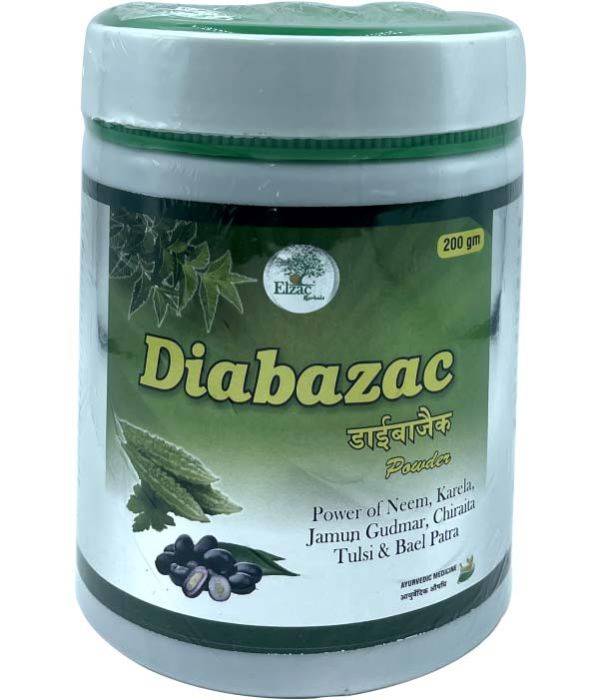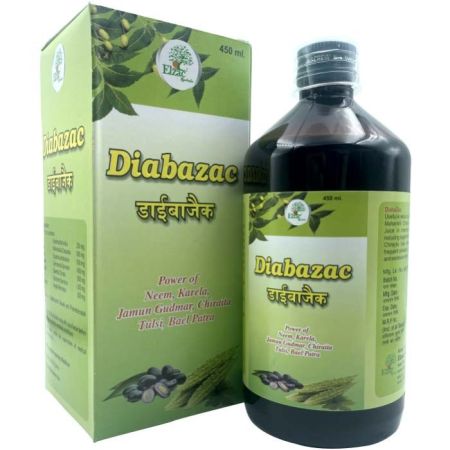Diabazac Powder 100 gm: Diabazac Powder is an ayurvedic remedies. It made from ayurvedic herbs which is helpful to manage diabetes. Let's talk its about the composition of Diabazac Powder.
Composition:
Each 10 gm Contains:
Methi Trigonella Foenum-Graecum 1000 mg Seed
Neem Azadirachta Indica 500 mg leaves
Bilwa Patra Aegle Marmelos 500 mg leaves
Punarnava Boerhaavia Diffusa Linn 500 mg Root
Arjun Twak Terminalia Arjuna 500 mg Bark
Karela Momordica Charantia 800 mg Fruits
Haritaki Terminalia Chebula 500 mg Fruits
Kallaungi Nigella Sativa 500 mg Seed
Jamun Eugenia Jambolana 500 mg Seed
Gudmar Gymnema Sylvestre 500 mg Stem
Chirayta Swertia chirata 300 mg Panchang
Tulsi Ocimum sanctum 300 mg Leaves
Ashwagandha Withania Somnifera 250 mg Root
Pushkar Mool Inula Racemosa Hook 100 mg Root
Tejpatra Cinnamomum Tamala 250 mg leaves
Gokshur Tribulus Terrestris Linn 150 mg Fruits
Jatamansi Nardostachys Jatamansi 150 mg Bark
Vijaysaar Pterocarpus Marsupium Roxb. 750 mg Stem
Trifala Classical 200 mg Fruits
Gular Ficus Glomerata Roxb. 200 mg Bark
Babool Gond Acaia Arabica 750 mg Exude
Indication: Madhumeh Nasak and Pramehenasak etc
Dosage: 10-15 gm twice a day or as directed by medical practitioner
Let us talk in detail about the medical properties of these herbs which are use in it.
Methi: Methi (Fenugreek) seeds is suppose to be many potential actions that are helpful in reducing sugar level in diabetic patient. One it has chemicals that may slow digestion and the body’s absorption of carbohydrates and sugar. Second, it may also improve how the body uses sugar and increases the amount of insulin released.
Neem: Neem is a traditional herbal remedy that is commonly used in Ayurvedic and other traditional medicine systems to help manage diabetes. It is has anti-diabetic properties, specifically by helping to lower blood sugar levels and improve insulin sensitivity. In addition, neem leaves are rich in antioxidants, which can help reduce oxidative stress and inflammation, which can be increased in diabetes.
Bilwa Patra: Bael contain active ingredients Feronia Gum which have reportedly shown helpful properties in controlling sugar level in diabetes. It regulates the production of insulin from the cells into the blood stream and low glycemic index of bael maintains the blood sugar level.
Punarnava: Punarnava is majorly used for kidney and urinary disorders. It tends to improve the functioning of kidneys damaged by diabetes.
Arjun Twak: Arjun Twak has powerful anti-oxidant property. It exhibits the antioxidant activity through correction of oxidative stress and helpful in maintaining diabetic blood sugar level.
Karela: Karela contains many active ingredients, out of which three active substances i.e., charanti, vicine and an insulin like compound known as polypeptide-p have a blood glucose-lowering effect. It contains a lectin that reduces blood glucose concentrations by acting on peripheral tissues and suppressing appetite – similar to the effects of insulin in the brain.
Haritaki: Consumption of Haritaki helps in production of insulin from the pancreatic β-cells. It also helps to reduce the breakdown of starch into glucose which in turn regulates the secretion of insulin and leads to low blood glucose level.
Kalonji: Kalonji, also known as black seed or nigella sativa, has been traditionally used in Ayurvedic and Unani medicine for various health conditions. It has beneficial effects on blood sugar levels and insulin resistance in people with diabetes.
Jamun: Glycoside present in the seed, jamboline, is considered to have antidiabetic properties. It lowers blood glucose levels and delaying diabetic complications including neuropathy and cataracts etc.
Gudmar: Gudmar improves insulin response to food and helpful to reduce the need of insulin therapy and oral hypoglycaemic drugs. Gudmar may also work by lowering sugar absorption thereby controlling blood sugar level after food.
Chirayta: Chirata is helpful in managing diabetes and diabetes induced kidney problems. It increases insulin secretion and reduces oxidative stress in diabetic patients due to its high antioxidant activity.
Tulsi: Antioxidant property of Tulsi appears to be predominantly responsible for hypoglycemic effect. It lowers blood sugar levels and helps prevent complications of diabetes.
Aswagandha: Limited evidence found that Aswagandha is useful in controlling sugar level but In several studies, ashwagandha has been shown to lower blood sugar levels.
Pushkar Mool: Pushkar Mool, also known as Inula racemosa or Pushkarmool. It is a perennial herb that is commonly used in Ayurvedic medicine. It has beneficial effects in managing diabetes, helpful to lower blood sugar levels, helpful to improve insulin sensitivity and also helpful to reduce oxidative stress in people with diabetes.
Tej Patra: Tejpatta is useful in diabetes due to its antioxidant and anti-inflammatory properties. Tejpatta prevents the damage of pancreatic beta cells and enhances insulin secretion.
Gokshur: An active compound present in gokshura called saponin has antioxidant properties which help in lowering blood glucose level.



 Diabazac
Diabazac 



